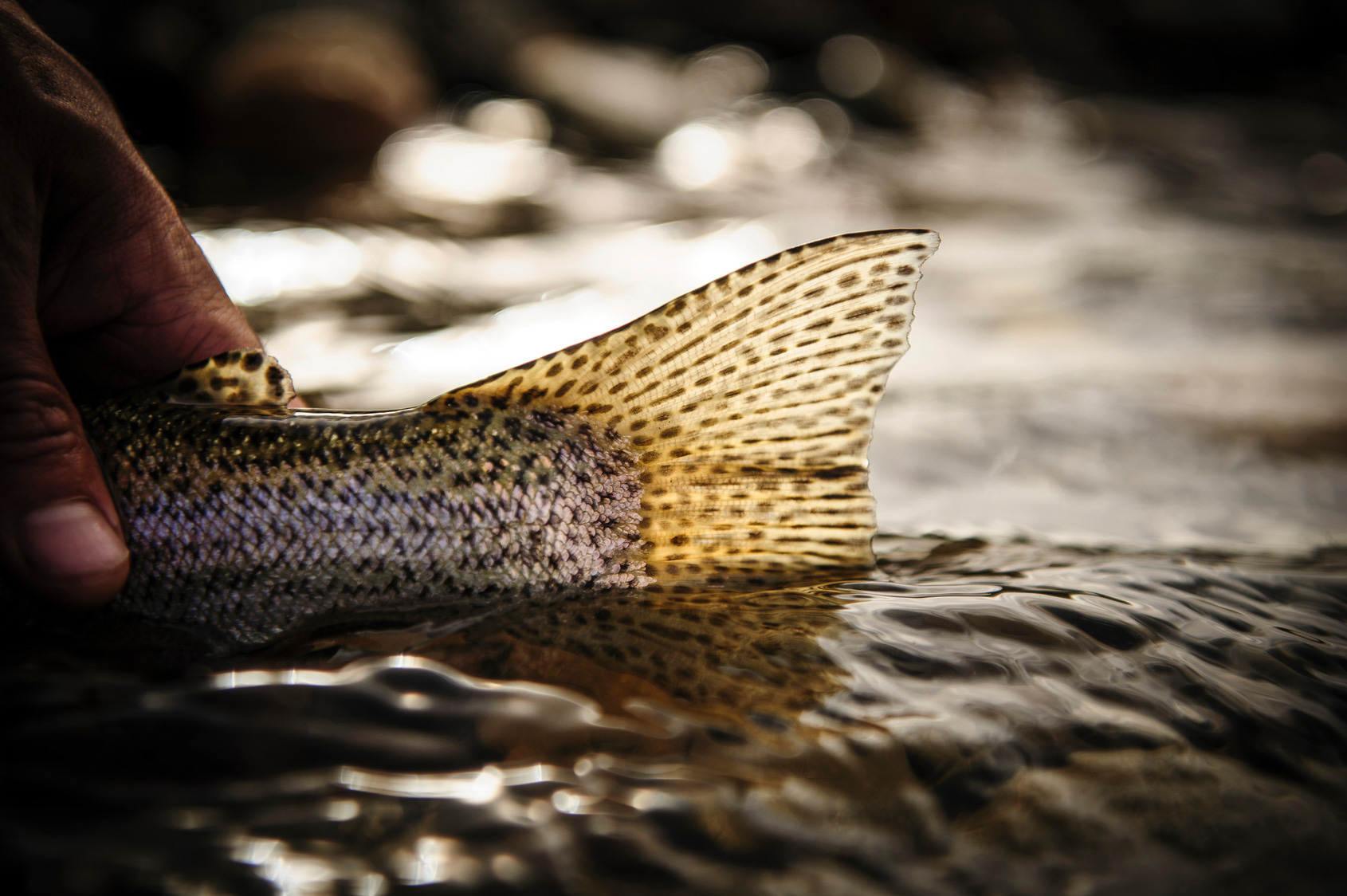WHEN THIS FISH took the lure, he did not explode in a geyser of white water. He did not rocket out of the water like a 12-inch projectile. He did not erupt, or detonate, or blast the lure, or attempt any of the other warlike measures commonly attributed to big fish in the literature of the outdoor magazines. Being intelligent, if not widely read, he tried to eat the lure.
Being also large and muscular and energetic, he approached his snack with enthusiasm. He jerked the reel handle out of my grasp and made it spin, removing tracts of hide from several knuckles. When the drag was set he came to the surface and leaped, just once. He came up pretty high and fell back on his side with a large splash.
He looked as long as a dishonest basketball player. I was scared. I had never seen a trout like this with my eyes open.
The fish dived. Our boat was drifting fast before a stiff wind but the trout wouldn’t come along. He was like a spoiled boy digging his heels in the earth when a parent tries to drag him. There were spasms of jerking that made the reel go zzzzaatt … zzzzupp … zaazzuuuutt!
In the stern of the boat Capt. Warren Smith realized that the fish had found refuge in the weeds. Twice he started the outboard and steered upwind above the fish, and we tugged timidly at the line. When we freed it the trout came up obediently, tuckered out by his struggles down there in the broccoli.
He was a lusty rainbow of 12 pounds with shoulders like Max Baer’s, magnificently colored, and splendidly deep, like Jane Russell. I killed him and helped eat him and I am still awed by him. I can’t shake off a feeling that I made a meal off Tony Galento. To me, that trout lives as a symbol of fishing in the Chilean Andes.
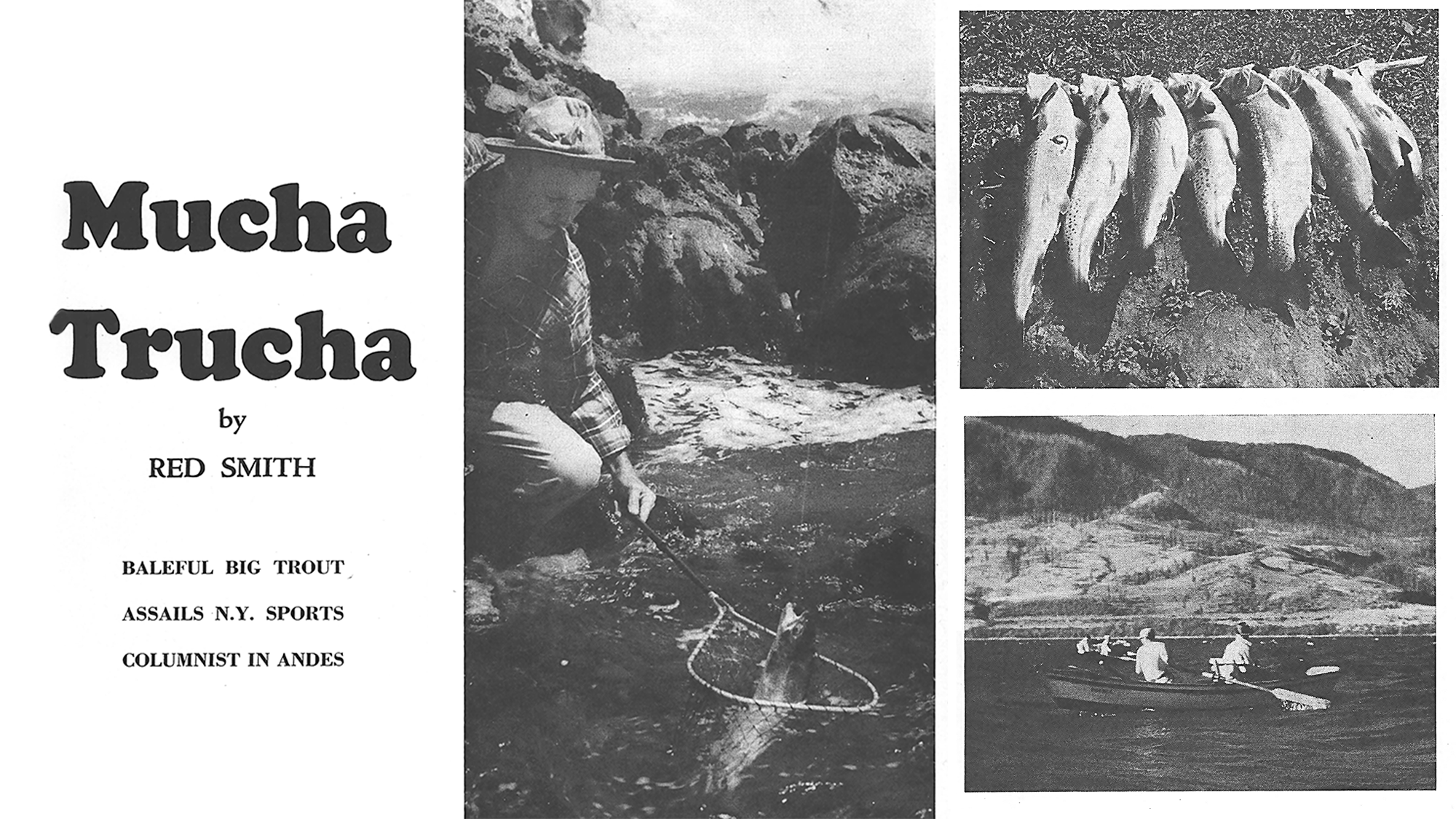
I am a clumsy, enthusiastic leisuretime angler with little leisure. Because I grew up in the Middle West I am a fresh-water fisherman, dedicated to trout and bass. Until January, 1953, my biggest trout was a 2½ to 3-pounder, caught in the Laurentian Mountains of Quebec.
IN THE EAST we think of the Laurentians as near, yet it takes as long to reach them by car as to fly 6,000 miles to Chile. It was midafternoon and winter had a hammer lock on New York when the plane left Idlewild Airport. A little after midnight the Pan American–Grace Airways ship paused in sweltering Panama. Dawn came up somewhere around the equator, and that afternoon we were having a tall, cool one beside the rooftop swimming pool of Santiago’s Hotel Carrera, ogling the dolls in swim suits. It was January, and midsummer.
Capt. Warren Smith is a big, bluff, ex-pilot for Panagra who flew up and down and back and forth across the cruel peaks of the Southern Hemisphere until they named him “King of the Andes.” He lived in Chile sixteen years, seems to know every cop and hack driver and railroad porter in the country, and he goes back from Miami every year for at least a month of fishing.
He is part owner with a group of friends of a cache of outdoor gear—rowboat, outboard motor, tent, sleeping bags, air mattresses, cooking utensils. He put in a half day loading this stuff onto an American-make pick-up truck that had been rented for us, complete with a blue-eyed Chilean driver named Herman (pronounced Airmon). A friend lent his camp boy, a mustached Chileno named Hernan (Airnon). The four of us rattled out of town, were stopped at a traffic cop’s barricade, and got a ticket. The cop had a whole pad of summonses already made out; he just filled in names, license numbers, and such misdemeanors as pleased his fancy when he made each pinch.
Our objective was Laguna del Maule, a lake such as you don’t see more than once in a lifetime. You go 150 miles south from Santiago to the ancient city of Talca, turn left, and climb ninety miles to the Chilean-Argentine border. (Chile is a skinny sliver of a country on the Pacific but due south of New York, a couple of thousand miles deep and averaging around 100 miles wide.)
The “road,” which is a euphemism with ruts, ends at the lake which perches a mile and a half high. There is nothing to the east save a wild, indescribably desolate scraggle of volcanic peaks crumbling into gray dust under the cold wind that blows eternally up the gorge of Río Maule from the west. Dead Chilean volcanoes, their crests touched with snow in midsummer, crowd the lake shore. Immediately beyond them you see Argentina’s mountains. This is a mountain pass, but high above timberline; there is not a tree, not a shrub, scarcely a blade of grass.
Like all Chilean waters, Lake Maule is matted with apancoras—small crawfish which look like miniature lobsters, dark on top and sort of shrimp-pink below. Apparently here are the tidbits trout have been looking for ever since Izaak Walton invented them. The fish smack their gills over the crustaceous canapés and grow to phenomenal size. All good Chilean fishing waters have produced trout weighing more than 20 pounds.
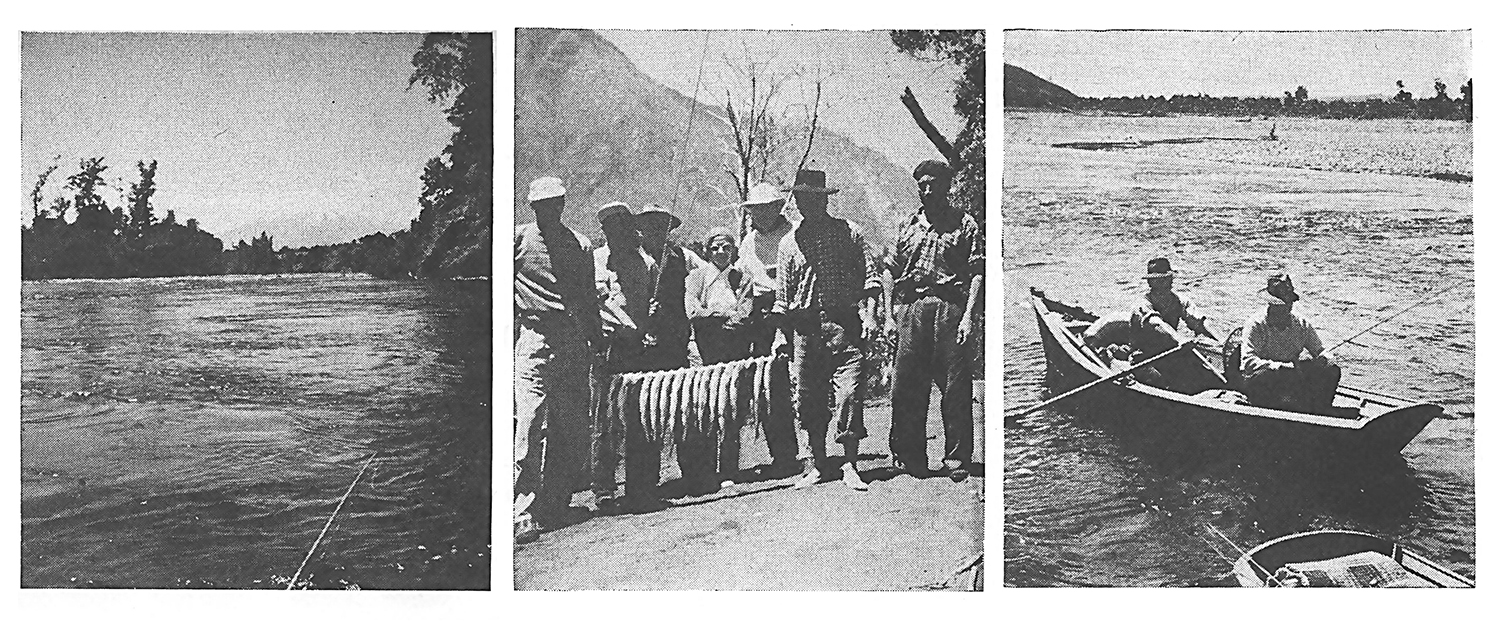
There are no native trout in Chile. There’s a native fish called “trucha chilena” (Chilean trout), because it was considered a trout before rainbows were imported from the United States about 45 years ago, to be followed by German browns from Europe. Groping for a name, Chileans called the newcomers “trucha salmonidea.”
The trucha chilena has the bronze back of a bass but the shape of a perch and there is nothing to recommend him except his succulent white flesh. Put a hook in his face and he behaves like a German infantryman; “Vateffer is the rules,” he mumbles, and comes along quietly.
Fish can’t commute between Lake Maule and the river which tumbles out of it toward the Pacific, because of a towering waterfall. There were, according to the tale, no trout in the lake until about a quarter-century ago when an old Englishman took some out of the river and trudged on foot up the mountains with the fish in milk cans slung over his horse’s back. The size and villainy they have attained since then testify to the quality of their shellfish diet.
Well, Herman blessed himself as we set out from Santiago, muttered a small prayer when we finally got past the traffic cop’s barricade, and we went clattering down through a lush valley of vineyards and eucalyptus trees with snow-capped Andes on the left and the lower coast range on the right.
PHYSICALLY the country looks like Southern California. Or, rather, this is how southern California would look if every movie company in Hollywood were on location filming epics of the soil. You keep passing bit players on horseback, swarthy vaqueros wearing pie-plate sombreros and brightly striped ponchos, which are varicolored blankets with a hole in the middle for the head, giving the wearer the appearance of a bug in a rug.
There were laden burros, and oxcarts whose two wheels were solid disks, just cross sections of tree trunks. Two little kids swam naked in a muddy ditch beside the highway. Short-tailed hawks wheeled in the hot blue sky.
So a rear tire blew out. One look at Herman’s gouged and blistered spares, and it was obvious this safari would hole up overnight in Talca while new tires were bargained for. So it was ordained.
In the morning while Herman haggled over tires, his passengers took a horsedrawn hansom to the city market and bought provisions from the women who squat on flagstones selling everything from big coils of seaweed (for making seaweed soup) to sections of old automobile tires (for making sandals). One purchase was eight kilos (about 17½ pounds) of sirloin, all meat and no bone, at 25c a pound.
“Maule?” said the hack driver when he learned where the expedition was bound. “Muy bonito río.”
It is that, a very pretty river. You go east from Talca for a while through a rich valley, then you start up a dirt trail and the river is below you. It is milky blue in the pools, foaming white in the rapids. The road is far above, a twisting shelf on the face of volcanic cliffs.
Houses grew fewer and poorer. They became shacks with thatched roofs and walls that were insubstantial tangles of crooked sticks and vines, live bamboo, and broom-corn stalks. The truck frightened flocks of tan-bodied, black-winged mountain doves. There was a roadside pond where a mamma duck gave swimming lessons to seven infinitesimal blobs of downy yellow. A pair of quail raced across the trail convoying a brood of tiny chicks. From the tail of a passing truck, grinning Chilenos brandished huge wine bottles aloft and toasted us, smiles gleaming white in olive faces.
The radiator of the pick-up boiled over. Herman stomped on the brakes and nothing happened. Oh well, the altitude was only about 5,000 feet at that point and brakes weren’t what you’d call vital. Every kilometer or so there was a mountain brook where water could be scooped up for the radiator. Thus, haltingly, timberline was reached.
Camp was pitched there among a sparse growth of chunky, small-leaved maitenes trees, the very last trees on the climb. While others did the work, I fished. Because the river was low—they’re building a dam at the lake, and sometimes water in the stream is shut off—Capt. Smith suggested using a small spinner.
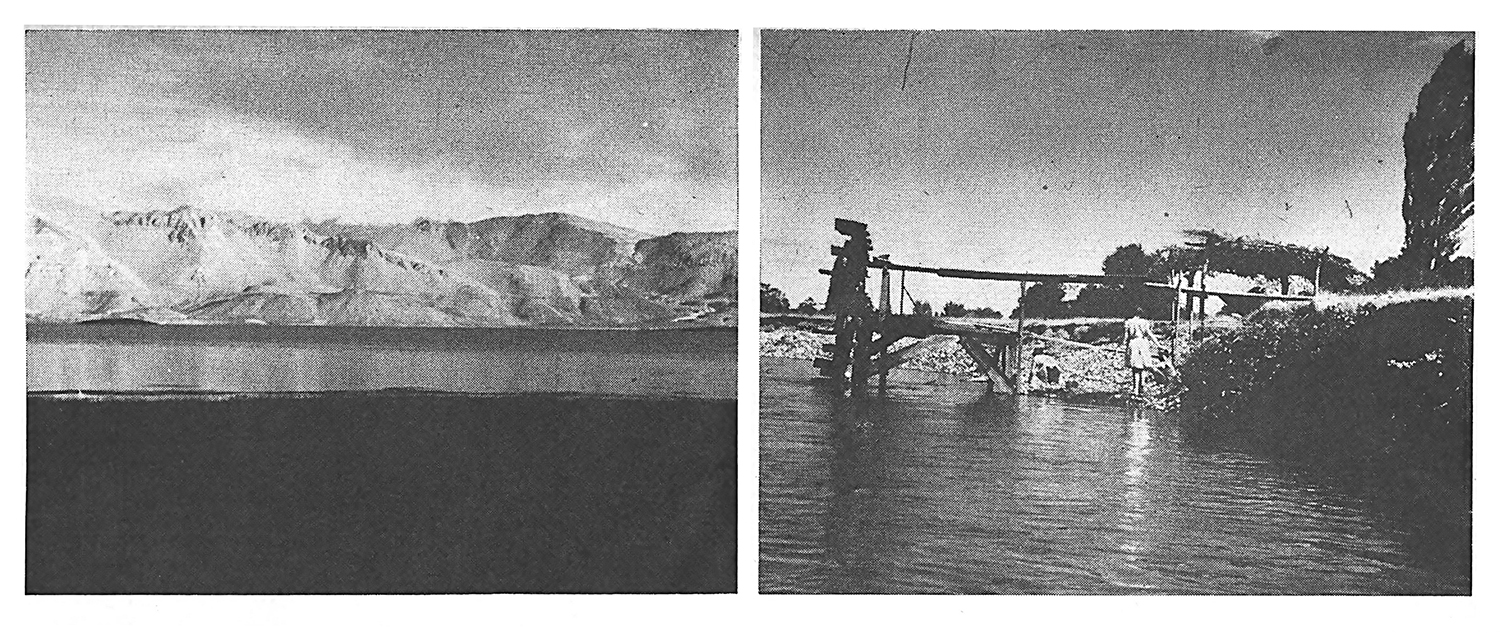
The trout were nuts about this metal dingus. One snatched it in a pool just above a succession of small falls, ran downstream, and vowed he’d smash the tackle of anybody who tried to bring him back up the rapids. A scrambling, stumbling pursuit ensued over boulders. The fish got loose, naturally.
Lots of fish were lost in a couple of hours. Eight or ten were landed and six kept for supper. They ran about 1 ½ pounds each and were displayed proudly to Capt. Smith, who started to snort, counted ten, and then said indulgently that they were nice trout. Capt. Smith is a tolerant man.
That evening Herman stood by the roadside stopping the few trucks going to and from the dam job above, seeking fluid for his bone-dry brakes. Nobody was carrying any, of course, but one Chilean genius said that although motor oil would ruin the brakes, wine could be used as a substitute because it contained alcohol.
Capt. Smith knew what contained more alcohol than wine. Out came the bottle of Scotch. Next morning the truck went buck-jumping up to the lake with a brake cylinder full of Scotch, the happiest car in Chile.
Herman, a teetotaler who loves his beat-up camioneta, had been unhappy about feeding it hooch. First time the bus topped a rise and pitched downward toward a precipice, he tried the tiddly brakes. They took hold like a lush clutching a lapel.
In twenty dizzying kilometers after that, Herman never stopped laughing. On the long haul up from Talca we had seen maybe three or four fishermen in the river. Capt. Smith said their lures were “terribles” (tay-reeb’ lace). Using a long cane pole cut from the woods, they wade the shallows and slowly, gently, work the current with a little flat metal minnow bristling with hooks. They catch fish.
Wet flies are effective in the river but there is no admiration in Chile for dry flies, perhaps because neither the trout nor the Chilenos see much insect life. Except for a lazy horsefly confined to a brief season on certain waters, there are no stinging bugs in the land—no mosquitoes or gnats or blackflies or midges or no-see-ums. Comparatively few hatches appear on the streams.
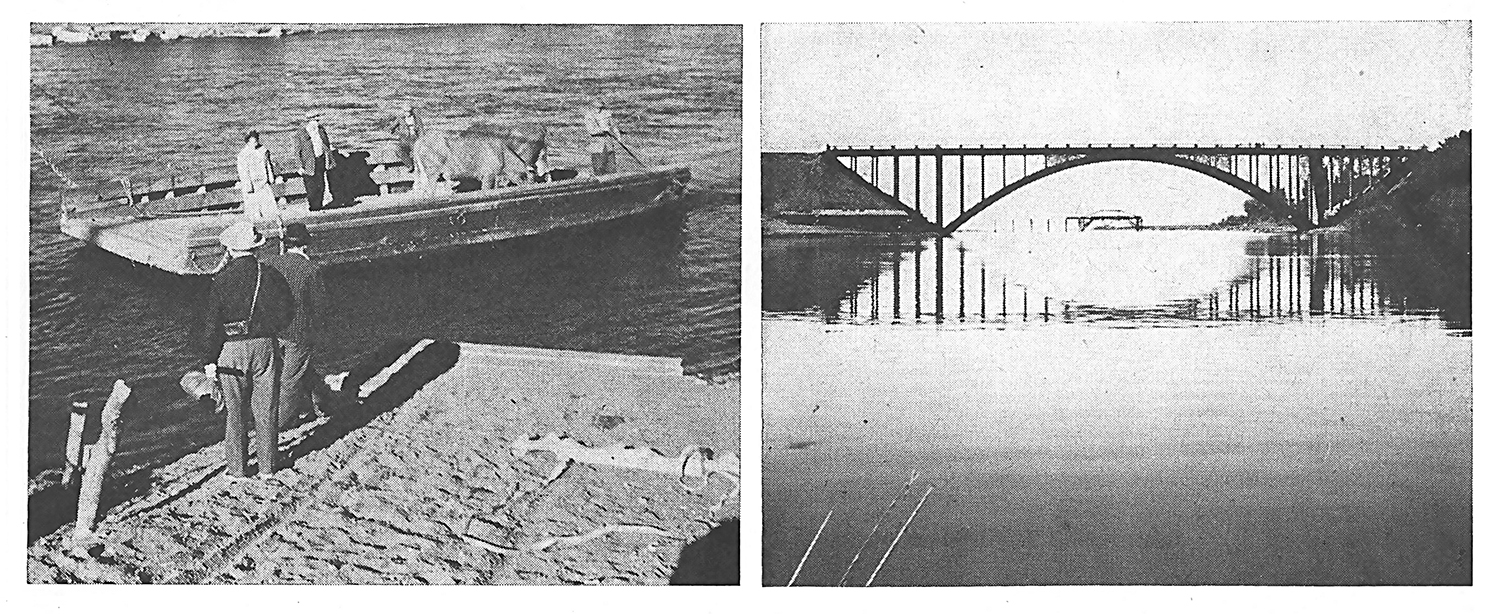
Obviously, a big wet fly in fast water looks like a minnow to a trout, until the hook bites back. Silver-bodied patterns are most highly regarded and the popular size is 1/0, the theory being that big flies grade out small fish.
Such as I am, I’m a fly fisherman but no purist like the companion Capt. Smith had on one trip. Somewhat like Sweet Alice, Ben Bolt, this guy wept with delight at the sight of a fly and trembled with horror at the thought of offering a spinner, spoon, or plug to a trout. “But,” said the captain, “the sucker would tie a fly on a 6/0 hook big enough to land sharks.”
Maybe on a calm day the trout of Lake Maule would rise for flies. Generally, though, they lie deep in a belt of weeds that circles the lake not far from the shore, munching apancoras and cultivating a venomous temper induced by the barren desolation around them. The accepted technique for striking up an acquaintance is to drift over the weed beds casting spoons or other gaudy hardware, much as one attracts a blonde with costume jewelry.
The idea of fishing trout with a casting rod gave me faint qualms, but when you’re traveling you drink the wine of the country. When we hauled boat and outboard from the truck we took only plug rods aboard, rigging them with bronze-backed spoons of scarlet and orange that had been recommended in a Santiago sporting-goods shop. A flyrod would have been useless, anyhow, in that day’s fierce wind.
EVEN IN THE lee of a point or rocky island, the wind was stiff enough to stop a cast in mid-air while bird’s nests burgeoned on the reel. On a cast downwind the drifting boat followed SO swiftly you had to reel like crazy or be snagged in the weeds a few feet below the surface. We settled for cross-wind casts from bow and stern.
I was still trying to get the hang of this and picking out backlashes when Capt. Smith grunted. In the same instant there was a noise as of a troop of Boy Scouts in the old swimming hole. I looked, and I didn’t believe it. I’m not sure I do now.
A Thing had the captain’s spoon. It wasn’t as big as a steam yacht or a beer truck or even a sea serpent, but it was angrier and much more agile than any of these. It was in and out of the water, and in and out, and around the boat from stern to beam and back again.
“No,” I said. “That’s not a trout.”
“It is,” the captain said. “Oops!” His reel was chattering.
At length The Thing came flopping aboard on a gaff, a beautiful brute, dark and silver with sunrise along the sides.
“He’ll go about nine pounds,” Capt. Smith said mildly. Then: “That first time you saw him jump,” he said, “he wasn’t on. He missed the spoon and came out of water and I let him have it again and he took it.”
This was on the first drift below a small point. We were to learn that strikes would come only close to the shore or over the weed belt. Farther out, where a rocky bottom could be made out dimly through the rough, clear water, no fish were shopping for metal gewgaws.
The captain caught several more fish, slightly smaller than his first, before my inept casts aroused troutly attention. Then there was a shock of contact and a dark body that seemed monstrous to my incredulous eyes leaped once and departed without ceremony. I had not set the hook.
Now I locked up with another. He need not have been as big as Primo Carnera, but he jumped four times in dazzlingly swift succession, and every time he got up on his tail and shook his head he grew taller. On the fourth jump the leader parted. He went away with a faceful of hardware.
The captain was chuckling. “Oooh, he was provoked,” he said. “I never saw a madder fish. That trout hates you.”
I didn’t care. I was laughing with joyous excitement. Those four shuddering leaps were what I had dreamt about, planning this trip at home. Several of my fingernails were broken. It was an untidy manicure, but well worth coming 6,000 miles to get. Losing the trout didn’t matter. I didn’t wish him dead.
The captain was right, though. In Maule the hatred is all on the side of the fish. They dislike people, they outnumber people, and sometimes they outweigh people.
Now a fish broke Capt. Smith’s leader. Then I lost one the same way. We had started with eight spoons, and when trout had taken six of them by force it filtered through two slow minds that something must be wrong with the 15-pound-test nylon, bought new in Miami. The leaders all broke in the same place, not at a knot but in the middle of the loop at top or bottom.
Conceivably a couple of those fish were heavy enough to break leaders on their own, but not all of them. We saw one plainly when Capt. Smith brought it to the surface close to the boat. He wasn’t being horsed in, and he wasn’t big enough to snap a sound leader, but he dived and went off with the spoon.
At length The Thing came flopping aboard on a gaff, a beautiful brute, dark and silver with sunrise along the sides.
With the two remaining spoons tied directly to the lines, no more lures were lost. We fished until midafternoon of this gusty, overcast day, then pulled up on the gritty shore for lunch. A small cliff of volcanic rock gave protection from the wind. It crumbled at the touch, pouring small avalanches into hip boots.
We were near the east end of the lake, some miles from the squalid construction camp at the dam site at the western outlet. We had seen one other boat with a fishing party. Otherwise there was no life save the ducks and geese and terns and grebes on the surface and the fish below. The loneliness of the scene lent it a kind of sullen majesty.
Wading and casting near the shore, I saw what looked like an ostrich egg floating near me. I picked it up. It was a floating rock, for Pete’s sake. Pumice.
Daylight lingers in summer at these altitudes but it was a dim day and we didn’t fancy
fancy teetering down that skimpy ledge of road after dark at the mercy of Herman’s rum-dum brakes. Consequently we didn’t fish overlong after the late lunch.
Not every float across the weed beds brought a strike, but we were never’ long without evidence of the presence and malice of these fish. At length Capt. Smith said, “What do you say we try it once more and then call it a day?”
It was on that last drift that I was assaulted by the 12-pounder, our best of the day. He was what the Chilenos might call mucha trucha, but whether they put it just that way I wouldn’t know. Chances are we caught about ten trout and lost as many more, counting those that made off with the spoons. We kept six, whose total weight must have been more than 40 pounds. We did not see one smaller than three or four pounds.
We were to meet a man later who told of a day when his party—I forgot how many rods—took 88 trout out of Maule, all between eight and 18 pounds. I was glad we could make no such boasts.
There is no creel limit in Chile. Since construction of the dam began the road has been “improved,” I was told, so that cars sometimes bring several hundred fishermen to the lake on a week-end. The dam is supposed to raise the level of the lake about 17 feet. What all this may do to the fishing in the next few years, one can only guess.
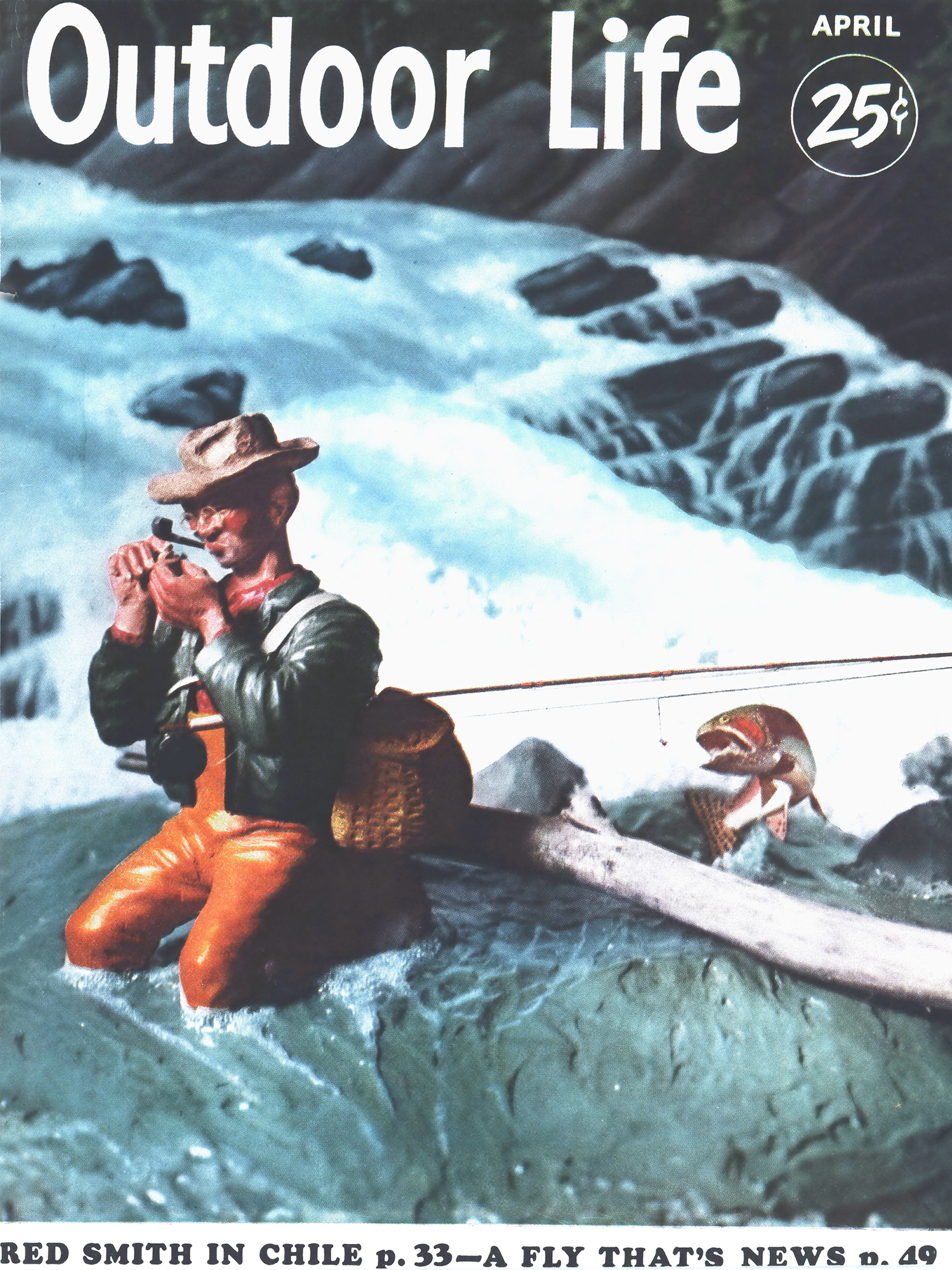
Creeping, shuddering, hiccuping down the face of precipices, we made timberline in about an hour. Darkness had beaten us into that deep gorge. (Hernan, the camp boy, told Capt. Smith he was unhappy camping there; the crags crowded him like cell walls.)
Unhappy or not, he’d been busy. The dusty ground under the maitenes trees had been tidied. A campfire was burning, a lantern hung from the tent pole, and under it a folding table was set with the first course for dinner—big, blushing tomatoes stuffed with the minced pink flesh of rainbow trout. This was only the beginning. Scotch and the frothing red wine of Chile are versatile fluids.
Sometime in the black middle of that night a shout from Capt. Smith emptied the sleeping bags. It had started to rain. Gear had to be hauled under cover. Next morning it was still raining, and cold.
Delays in Santiago and on the road had cut one day off the fishing schedule. Now the weather ruled out plans for further experiments on the river. Between rain squalls, camp was struck and the truck overloaded.
The old pick-up shivered down the greasy trail through howling rains. At a carabinero station the soldier-cops said it was snowing that morning up at the lake. Once the truck had to stop because boulders had been washed onto the road from the cliffs above. We rolled them over the shoulder. They plunged out of sight, crashing faintly.
BACK AT TALCA Capt. Smith and I would take a train to the lake-and-river country some 350 miles south. Herman, Hernan, and the six big fish turned north for Santiago and a freezer.
Departing, Herman said miserably, “I am sorry. My camioneta is not good enough.” He needn’t have apologized. Riding his truck, such as it was, was better than crawling to Maule on all fours over broken beer bottles, and that would not have been too high a price for such trout.
In this melting-pot nation of ours there are people who admire basketball, and people who vibrate with pleasure at a ballet, and people—hundreds of thousands of them—who consider a three-pound rainbow trout nobler, lovelier, and more desirable than Marilyn Monroe. For these latter, the sky-top waters of Laguna del Maule would be Shangri-La with knobs on it.
It is a long way to go, though, and any pilgrim undertaking the journey should not forget the grog. Snake bite it not a hazard in Chile, but you never can tell about hydraulic brakes.
This story, Mucha Trucha, originally ran in the April 1953 issue of Outdoor Life. Read more OL+ stories.
